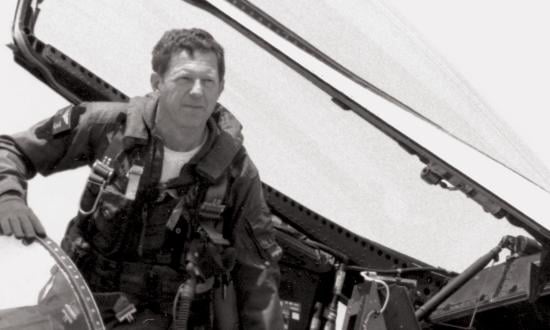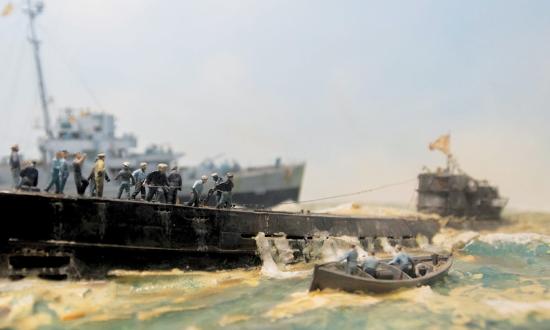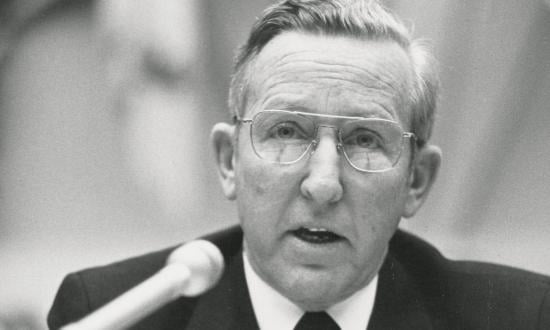Medal of Honor recipient Ernest E. Evans is justifiably famous for his display of supreme courage while in command of the USS Johnston (DD-557) during the Battle of Leyte Gulf, when he attacked an overwhelming Japanese force of battleships and cruisers. Arguably there are acts of courage in U.S. naval history that equal what Evans did, but none exceed it. In one account, the captain of a destroyer escort passing close by Evans’ ship at the height of the battle recalled:
As the mangled destroyer passed close by [the Samuel B.] Roberts, Copeland could see her Cherokee skipper on the fantail, shouting conning orders down through the hatch leading to the after steering compartment. Evans was stripped to the waist and covered with blood. As [the] Johnston steamed by, Evans looked up at Copeland and casually waved. Copeland returned the gesture, not realizing at the time that he was waving farewell to this incredibly brave man.
The story of Evans in that battle has been told many times, but his entire naval career, beginning with his time at the U.S. Naval Academy, is less widely known. Midshipman Evans was described in his class yearbook—the 1931 Lucky Bag—as “big-hearted” and “good company” and, with no further explanation, “radical from birth.” Coincidence or destiny, the endpapers of that same Lucky Bag were embellished with a colorful painting of John Paul Jones and his famous words: “Give me a fast ship, for I intend to go in harm’s way.”
In the early 1930s, aviation was still viewed as somewhat experimental and secondary to the surface navy with its big-gun battleships and cruisers—but it was also dangerous and attracted the more daring individuals. An early indication that he was one of the latter, Ensign Evans opted for aviation and was accepted into flight school. Poor hand-eye coordination washed him out and he was sent to the surface fleet, where he first reported to the battleship Colorado (BB-45). He then served in a number of different ships over the next decade.
In 1941, Evans was serving as executive officer in an aged Clemson-class destroyer—the USS Alden (DD-211)—as part of the Asiatic Fleet. After the attack on Pearl Harbor, the Japanese went on a rampage across the Indo-Pacific, including invading the Dutch East Indies. The British, Australian, and Dutch ships in the region joined with the Asiatic Fleet to form what became known as ABDA, an acronym symbolizing the participants. A series of engagements culminated in the Battle of the Java Sea, which pitted the remaining ABDA ships, including the Alden, against a superior Japanese force of cruisers and destroyers.
Hampered by the geriatric status of the ABDA ships and by the confusion resulting from their different languages, the motley assemblage made a bold but ultimately sacrificial attempt to thwart the Japanese force from carrying out its invasion of Java.
For most of the battle, the Dutch admiral in command kept the U.S. destroyers on the disengaged side of the formation because their slower speeds and small-caliber guns made them all but useless in the cruiser slugfest. Toward the end of the melee, the American “tin cans” got their chance to join the fight and charged at the Japanese cruisers, expending all their torpedoes before making a well-advised retreat. It is unclear whether any of the torpedoes found their targets, but the Japanese force temporarily turned away, buying time for the remaining ABDA ships (by then reduced to four cruisers, one Dutch destroyer, and the four U.S. destroyers) to escape.
In the ensuing darkness, the U.S. destroyers became separated from the rest of the force, which proved fortuitous, because all the other ships were subsequently sunk. This left the four destroyers to make a harrowing but successful escape through the Madura and Bali straits, after a brief encounter with a pursuing Japanese force.
For the next eight months, Evans remained in the backwaters of the war until 27 October 1943, when he was given command of a fast ship, the brand-new Fletcher-class destroyer USS Johnston. Evans’ command would last just two days short of a year, when he would make history at Leyte Gulf.
During that year, the Johnston provided gunfire support to the landings on Kwajalein and Eniwetok in the Marshalls. The boldness that would later immortalize him was already evident as Evans took his ship close to shore, often arriving ahead of the assault waves, sometimes even dropping anchor to stabilize his guns for accurate fire, retreating only to resupply his ammunition for a return bout. At Guam in the Marianas, the Johnston was close enough to spray enemy-infested bushes with 40-mm rapid fire, drawing return fire that rattled shrapnel against her superstructure. In May, Evans earned a Bronze Star when the Johnston teamed with two other destroyers to sink a Japanese submarine.
The Johnston continued westward across the Pacific until the fateful morning of 25 October 1944, during the Battle off Samar, when Ernest Evans ordered “left full rudder, all engines ahead flank” and charged headlong into a formidable formation of Japanese battleships, cruisers, and destroyers, bringing to life the words of John Paul Jones as emblazoned on Evans’s yearbook: “Give me a fast ship, for I intend to go in harm’s way.”








